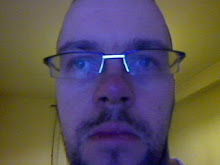The photograph I added to my profile truly is the face of Asperger's Syndrome. A cursory glance at it erases any of the lingering doubts I might have.
Blank expression, dead eyes, behind which there is dammed a limitless cathexis, give the game well and truly away. What a textbook case I am! I searched eagerly for a mugshot which conveyed any sense of human sentiment whatever - but all are akin to staring at the unflinching bone exterior of the deceased.
Nothing stirs the shuttered, fleshless interface that was broken irreperably somewhere along the line - either that or I was poleaxed from the moment of my premature birth. I connect only weakly with all that exists outside the quiet, solipsistic boundary marked 'I.' I always felt disconnected: like neon, I shine without reacting.
A 'deficit' is the name given by psychologists to such phenomena - a cruel but accurate summation. Those who have been picked up by the corpus calossum and dropped from a great height; those who mistake dustbins for children; those who shrink away from social engagements, all are considered under the umbrella term 'deficit.'
Laughing without feeling laughter; expressing joy when there is none. This is to separate the fish from its swim, the bird from its song, and God from his miracle.
The secondary characteristics that define what it is to be human - not the strictly necessary ones of eating, drinking, sleeping, defecating - but the ones on the next-bottom layer of the pyramid relating to empathy, reciprocity, feeling, interest, understanding, are absent in those with a shattered interface.
I speak of absence, and yet it is an absence that I am aware of. Despite never having known what it means or feels like to be an integrated, undamaged human, I still can express the idea of what it means to be that way. The unending schemata, put together through observation - when to smile, when to speak, when to express sympathy.... I do all of it artificially, yet adequately enough to pass muster.
'Knowing absences' relate to things which once orbited the transience of our lives which are subsequently longed for: friends we no longer see; the cat which owned me when I was a child; love ones who are no longer here, or individual memory sets relating to single events: the night Barnsley beat Chelsea; the day I thought I stumbled on the love of my life in London; when I first felt convinced I'd written something complete.
People, and events, leave identifiable holes in our person (consciousness) which we then go about filling with a rainbow of memories and analogies. We can fill them well enough, because we know what shape analogy fits in any particular gap.
What, though, of the unknowing absence? I contended above that I observe the schematics of human behaviour, and then proceed to imitate it, and thus manage to divert the view of other humans from the vast black hole which turns within me. Is the schematic theory broad enough to explain not only the observation/imitation argument, but to furthermore explain the certainty that I know how humans feel as they are laughing, crying, being flirtatious, arguing?
"If I've lived once, I might as well have lived a thousand times, or a million."
Does this complicated, improbable idea not answer every question that can be posed about how a quasi-Asperger's sufferer nevertheless knows what it is to feel, to love, to hope, to dream?
"Old souls accumulate knowledge and are re-born with it intact in some kind of Lamarckian imperative."
And so it is the case. The South African lady, and L, suddenly find that their cyclical assessment of human existence is given some unexpected credence.
If I have lived before (as a human with other deficits, or none at all) then the residue of that existence might persist into this, my nth trip on the endless rollercoaster of homo sapiens. It explains how a person might be irreversibly detached from, yet tentatively attached, to the humour, inquisitiveness and flirtatiousness of other people, without ever being able to genuinely make such gestures themselves.

